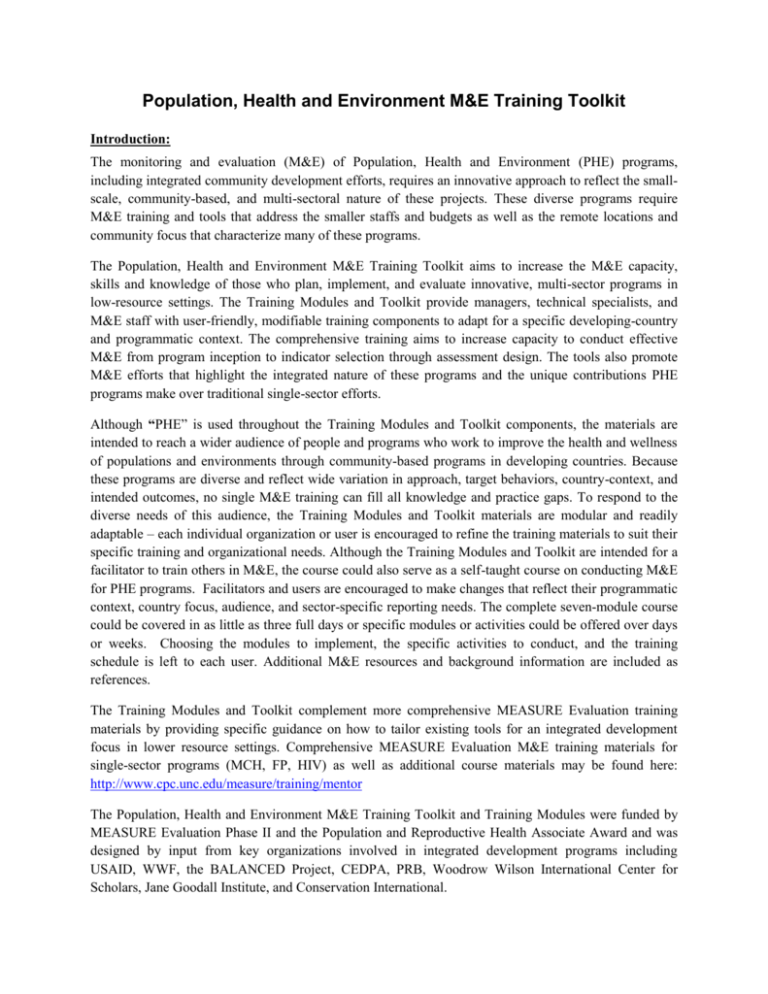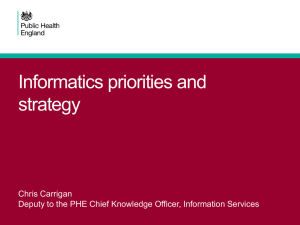Monitoring and Evaluation of Population, Health, and Environment
advertisement

Population, Health and Environment M&E Training Toolkit Introduction: The monitoring and evaluation (M&E) of Population, Health and Environment (PHE) programs, including integrated community development efforts, requires an innovative approach to reflect the smallscale, community-based, and multi-sectoral nature of these projects. These diverse programs require M&E training and tools that address the smaller staffs and budgets as well as the remote locations and community focus that characterize many of these programs. The Population, Health and Environment M&E Training Toolkit aims to increase the M&E capacity, skills and knowledge of those who plan, implement, and evaluate innovative, multi-sector programs in low-resource settings. The Training Modules and Toolkit provide managers, technical specialists, and M&E staff with user-friendly, modifiable training components to adapt for a specific developing-country and programmatic context. The comprehensive training aims to increase capacity to conduct effective M&E from program inception to indicator selection through assessment design. The tools also promote M&E efforts that highlight the integrated nature of these programs and the unique contributions PHE programs make over traditional single-sector efforts. Although “PHE” is used throughout the Training Modules and Toolkit components, the materials are intended to reach a wider audience of people and programs who work to improve the health and wellness of populations and environments through community-based programs in developing countries. Because these programs are diverse and reflect wide variation in approach, target behaviors, country-context, and intended outcomes, no single M&E training can fill all knowledge and practice gaps. To respond to the diverse needs of this audience, the Training Modules and Toolkit materials are modular and readily adaptable – each individual organization or user is encouraged to refine the training materials to suit their specific training and organizational needs. Although the Training Modules and Toolkit are intended for a facilitator to train others in M&E, the course could also serve as a self-taught course on conducting M&E for PHE programs. Facilitators and users are encouraged to make changes that reflect their programmatic context, country focus, audience, and sector-specific reporting needs. The complete seven-module course could be covered in as little as three full days or specific modules or activities could be offered over days or weeks. Choosing the modules to implement, the specific activities to conduct, and the training schedule is left to each user. Additional M&E resources and background information are included as references. The Training Modules and Toolkit complement more comprehensive MEASURE Evaluation training materials by providing specific guidance on how to tailor existing tools for an integrated development focus in lower resource settings. Comprehensive MEASURE Evaluation M&E training materials for single-sector programs (MCH, FP, HIV) as well as additional course materials may be found here: http://www.cpc.unc.edu/measure/training/mentor The Population, Health and Environment M&E Training Toolkit and Training Modules were funded by MEASURE Evaluation Phase II and the Population and Reproductive Health Associate Award and was designed by input from key organizations involved in integrated development programs including USAID, WWF, the BALANCED Project, CEDPA, PRB, Woodrow Wilson International Center for Scholars, Jane Goodall Institute, and Conservation International. The online course materials, toolkit, and additional resources are also available on a CD-Rom. Training Objectives: To increase understanding of the basic concepts and practical approaches for performance monitoring and evaluation for integrated population, health, and environment (PHE) programs To learn state-of-the-art tools and techniques used specifically to monitor and evaluate PHE programs To gain hands-on experience in designing components of monitoring and evaluation plans for PHE programs Training Audience: The Training Modules and Toolkit are written for people-centered programs with a focus on health, population, and environment interventions. The monitoring and evaluation (M&E) knowledge and skills promoted in these materials is largely borrowed from the health and population sectors and applied to an integrated programming context to reach a broader audience, specifically those who work in integrated community development programs in developing countries. The Training Modules and Toolkit are most useful for: Organizations that are familiar with PHE programs and the PHE approach Staff who are involved with monitoring and evaluation in an integrated programming context Managers and staff who design, plan, and implement PHE programs Consultants and trainers of technical staff in integrated PHE programs The Training Modules and Toolkit are geared for programs that: Involve active partnerships between communities, non-government organizations, or government entities Promote an integrated, community-based approach to problem solving Operate in limited resource settings (smaller budgets) Collaborate between PHE sectors by implementing activities in multiple programmatic areas including, but not limited to: family planning, education, income generation, natural resource management, gender, sanitation, or agriculture. Training Modules and Toolkit Components: The Training Modules contain seven modules, all included within one set of PowerPoint slides. The facilitator notes are provided in duplicate: once in the embedded notes section of each slide and again as a stand-alone Word document. The notes are exactly the same in both locations. The notes included within the PowerPoint slides facilitate learning for a single user while the same notes as a stand-alone document aid a facilitator in the presentation of the training modules. Each module has practice activities included, with instructions, and these are set apart by a green background. The Toolkit provides all the resources needed to conduct the course, including the activities, additional training materials, and additional M&E resources. The Toolkit contains three separate folders: 1) Training Activities – separate, ready-to-print, handouts for the activities; 2) Additional Training Materials – support resources, background documents, and additional tools for the Training Modules; and 3) Supplemental PHE M&E resources – resources on M&E, surveys, and additional technical resources. How to use the Training Modules and Toolkit: Notes for the facilitator: All directions and comments for the facilitator are noted in ALL CAPS and enclosed in [brackets] throughout the materials. These include issues for further reading, ideas on adaptation, suggested review materials, and notes about leading discussions, activities, or presentations. Comments for the facilitator to read to participants are written in sentence case without brackets. The facilitator notes included with the slides are the exact same as those included in the separate Word document. Users may choose the format that best suits their needs. Training Module components: Each training module, other than the introduction, has the same layout. The module title slide lists any resources or materials that will be needed for the module including copies of specific tools or activity preparation. The modules begin with a brief overview, providing participants with an understanding of the flow of the session and the major components to be covered. The overview slide provides introductory comments for the facilitator. The overview is followed by a slide on module learning objectives that describe what participants will learn in the module, including the expectations for knowledge or skills to demonstrate by the end of the session. Subsequent slides present the technical content of the module. Slides and facilitator notes frequently include discussion questions to encourage participation and active engagement. Large group discussions, partner activities, and small group work is incorporated throughout the training, and small group activity slides are colored green. Although an approximate amount of time is suggested for every activity, the facilitator will have to adjust the activity timing to meet the needs of participants. Group work A small group project is incorporated throughout the training course to facilitate the transition from knowledge to practice. Participants should come prepared to work on their specific PHE program in groups of 4-6. If participants do not have a program, they may work from one of the examples provided (IPOPCORM or the PHE indicator matrix example). Participants who complete the activities included throughout the training will gain experience: Designing a program conceptual model (Module 2) Designing logic models (Module 4) Identifying appropriate indicators from multiple sectors, including integration and value added indicators (Module 5) Selecting appropriate indicators (Module 5) Filling in an indicator reference sheet (Module 6) Completing a comprehensive indicator matrix (Module 6) Considering data collection needs, including qualitative and quantitative method (Module 6) Choosing appropriate assessment methods (Module 7) As a result, at the end of all the training, each group will be able produce the key elements of an M&E plan, including the indicators, a plan to gather the information, assessment design, and who needs/wants the data. The training products can be based on a program that participants bring to the workshop or on an example PHE program. Throughout the course, each group will present the components and receive feedback from other participants and the facilitator. Training Modules: Module 1 Topic Training overview 2 Frameworks, Part 1 – Conceptual 3 Introduction to M&E 4 Frameworks, Part 2 – Logic models 5 Indicators Key components Training audience Training objectives Introduction to PHE Reasons for integration Added value of PHE Summary of three frameworks Purpose of frameworks Conceptual frameworks Alternative conceptual frameworks SMALL GROUP ACTIVITY: drawing a general conceptual model Goals and objectives Writing integrated goal and objectives Practice writing goals and objectives SMALL GROUP ACTIVITY: drawing your own project’s conceptual models, writing goals and objectives Definitions of monitoring and evaluation M&E plans Considerations for M&E of PHE Presentation of “A Guide for Monitoring and Evaluating PHE Programs” Demonstrating integration Defining “Value Added” from PHE Special considerations for M&E of PHE Stakeholders for PHE Decision making Data use for PHE SMALL GROUP ACTIVITY: beginning group project work Logic model overview Terminology Logic model examples Logic model overview Definition of an indicator Characteristics of good indicators Partner activities for indicators Factors to consider when selecting indicators Challenges for indicators for PHE Review of indicators in the Guide Integration indicators Slides 1-18 19-44 45-68 69-79 80-127 6 Frameworks, Part 3 – Indicator matrixes 7 Assessment and evaluation design Value added indicators Integrating gender Indicator metrics Adding indicators to logic models PARTNER ACTIVITY: adding standard indicators to a singlesector logic model PARTNER ACTIVITY: adding standard indicators to an integrated activity logic model Common pitfalls in indicator selection How many indicators? Key questions to ask when selecting indicators SMALL GROUP ACTIVITY: Adding indicators to your specific logic models 128-145 Overview of indicator matrixes Definition of an indicator matrix Data needs for M&E Data needs for decision making Internal vs. external data sources Data sharing for PHE Evaluating secondary data Giving credit to partners Moving from logic models to indicator matrixes Presentation of sample indicator matrix GROUP ACTIVITY: reviewing the example PHE indicator matrix SMALL GROUP ACTIVITY: preparing for the indicator matrix SMALL GROUP ACTIVITY: completing an indicator matrix with six indicators; writing an indicator reference sheet 146-162 Capacity and resources for M&E of PHE Types of assessments for PHE programs Overview of adequacy assessments Features of adequacy assessments Examples of adequacy assessment designs Features of a plausibility design Examples of plausibility designs Hints for choosing the right design SMALL GROUP ACTIVITY: planning an assessment Toolkit Materials Folder Location Training material name Training Toolkit Components Module Introduction to PHE M&E Toolkit Training modules Facilitator notes A Guide for Monitoring and Evaluating Population-Health-Environment Programs Activity Handouts Logic model – blank Logic model with indicators – blank Indicator reference sheet – guided Indicator reference sheet – blank PHE complete indicator matrix – example Indicator matrix – blank 4 5 6 6 6 6 Supplemental Material Participant pre-test assessment of PHE knowledge – example Participant post-test evaluation – example Brief training evaluation PHE – example List of additional training resources and references For Advanced Users Supplemental questionnaire slides and activity PHE draft baseline assessment tool Training preparation for a facilitator: If you are leading this course as a facilitator, preparing months or weeks in advance is advantageous for the successful implementation of these M&E training modules. These are some of the tasks and issues you should consider before implementing this training: 1. Read through the entire set of Training Modules PowerPoint slides to become familiar with the included modules, their components, and the practice activities that accompany the modules. 2. Carefully read through Toolkit materials, concentrating on the Training Activities and Additional Training Materials documents. Familiarize yourself with the included materials for the course, including the logic model, indicator matrix, and baseline assessment tool. Thoroughly review the Guide for Monitoring and Evaluation of Population-Health-Environment Programs. Consider reviewing the materials provided in the “Supplemental PHE M&E Resources” folder. 3. Determine the M&E training needs of the participants. What do they know? What do they want to learn? What skills do they have and what gaps do they wish to fill? What are their expectations for M&E knowledge or materials as a result of the course? 4. Determine the training timing. How many hours or days will they have? Will the course be mandatory or elective for the participants? 5. Assess your training skills. Are you the facilitator? Do you have people to co-facilitate with you? Do you feel comfortable and confident to modify the training materials to meet participant needs? Do you need to seek additional help to match the course materials to the audience? Are you comfortable presenting the materials to the selected audience? 6. Select the Training Modules and Toolkit activities that best meet the M&E capacity needs of the intended participants. 7. Review the PHE approaches of the participants for examples from their program. Become familiar with their program activities, the current M&E efforts, and the specific duties of the staff who will attend the training. 8. Review the Training Modules thoroughly, adapting them for the target audience, their skills level, or their M&E needs. Adaptations may include: changing the text of the facilitator text to match examples from your field program; adding in examples from your field program; determining effective groups for course projects; filling gaps in the training materials, and removing sections that do not fit your training needs. Modify the pre-test and post-test (found in the Toolkit “Additional training materials” folder) to reflect the needs of the participants. 9. Complete all of the Toolkit practice activities on your own, including partner and small group work. Make adjustments to the activities, if needed, to better fit the learning objectives of the participants. Review the instructions and revise as needed for clarity. 10. Prepare the training materials for participants. This includes enough copies of the following materials for all participants: All slides with room for notes Blank logic model – PowerPoint slide Blank logic model_with indicators – PowerPoint slide Indictor reference sheet_guided – Word document Indicator reference sheet_blank – Word document PHE complete indicator matrix example – Word document Blank indicator matrix – Word document Hard copies of the Guide for Monitoring and Evaluation of PHE Programs Pre-test and Post-test CDs of additional materials if possible Pens/pencils Optional: name tags; attendance sheet; binders for participants; certificates of completion 11. Prepare the materials needed for group work including: Scratch paper Three markers per group Pens/pencils for all participants Butcher paper or other large paper/posterboard Blackboard or other large writing surface Tape or easels with clips for presenting group work Flip charts 12. Prepare the training room LCD projector and screen (with laptop) Extension cords Sufficient outlets Desk/workspace for all participants Break-out rooms for group work 13. Prepare and send materials to participants in advance of the course Before attending, all participants should complete this free, online, two-hour course: http://www.cpc.unc.edu/measure/training/mentor/me_fundamentals Send out workshop logistics (for example, where the workshop is being held, where participants are staying) Expected time of the workshop 14. Practice running the training Meet with your co-facilitators (if applicable) Review course components and activities Practice the timing of slides and activities Prepare some backup plans if the module is either too difficult or too easy – knowing which slides/components you might skip or activities you might add Confirm that supplies and copies are ready for the training so you can concentrate on facilitating a quality course






